LenovoEMC px12-450r NAS review and test
LenovoEMC px12-450r was designed primarily for medium and small businesses, however, it will serve as a workhorse for data storage in many corporations, as it is equipped with a quad-core Intel Xeon processor, redundant, hot-swappable, power supply, four-channel aggregation on Gigabit interfaces Ethernet and an optional 10GbE dual interface expansion network card. The px12-450r Network Array combines EMC storage technology with a hardware platform and interface designed to expedite configuration and use. This is the flagship device of the joint activities of Lenovo and EMC, until 2013 sold under the brand name Iomega.

The technical specifications of the LenovoEMC px12-450r combined with the corporate functionality of EMC's LifeLine operating system mean that the px12-450r meets comprehensive storage requirements for small and medium businesses and remote office setup. With access to the EMC technology portfolio, the joint venture offers EMC Amavar data deduplication, integrated IVX imaging technology, EMC Atmos Cloud Connector, LifeLine-to-LifeLine copying and fault tolerance. This also applies to Lifeline developer apps. The px12-450r network array is flexible enough to integrate into existing networks as the target system for backup, data storage, or high-quality image storage.
LenovoEMC px12-450r NAS can be diskless, equipped with 4 RAID 5 drives, or equipped with a 48TB capacity in a RAID 6. The model we are considering is equipped with an additional 10Gbase-T PCI expansion card with two interfaces that will help evaluate the performance when using a solid state drive.
The LenovoEMC px12-450r 2U high is supplied with a guide rail for 19 "standard units. The front panel provides access to 12 3.5-inch drive bays that can be used with hard drives or SSDs. The panel also has a power button, Power LED and USB port: Each drive bay is equipped with an LED indicator to indicate the status and activity of the drive.

The rear panel is equipped with connectors for two power supplies, which are automatically adjusted according to the input voltage. The System ID LED for device identification is activated using LifeLine management software, and the reset button resets the network and security settings without the need to completely return to the factory settings.

The px12-450r is equipped with two additional USB ports on the rear panel, as well as four integrated 1GbE interfaces. The VGA port can be used in conjunction with the video monitoring function. The device in question makes it possible to additionally connect 10GbE ports using a network expansion card.

LenovoEMC px12-450r is easy to maintain and repair due to the modular design of the motherboard, which can be easily separated from the chassis, being in the same unit with expansion cards. By unscrewing the two screws, you can upgrade your px12-450r in a few minutes with our optional 10GBase-t card.
Lenovo EMC NASs are powered by EMC LifeLine, a Linux-based operating environment that provides built-in management and integration tools and access to third-party applications. LifeLine provides access to subfile deduplication technology for backup data, as well as support for integrated IVX imaging technology for simultaneous management of several virtual machines on the px12-450r. In addition, Windows Distributed File Network (DFS) support allows you to organize network files into a unified directory tree. LifeLine also provides extra capacity by adding USB hard drives as shared resources.

LenovoEMC px12-450r NAS can run video monitoring installed in Mindtree software. In addition, the device comes with Mindtree SecureMind VSMS software with the ability to use on a single camera. LenovoEMC px12-450r can use up to 48 IP cameras along with additional integration with Axis Video Hosting Solution (AVHS) for security and other video applications. LifeLine is compatible with third-party cloud services, including Amazon S3 or Mozy, and with EMC Atmos Cloud Connector.
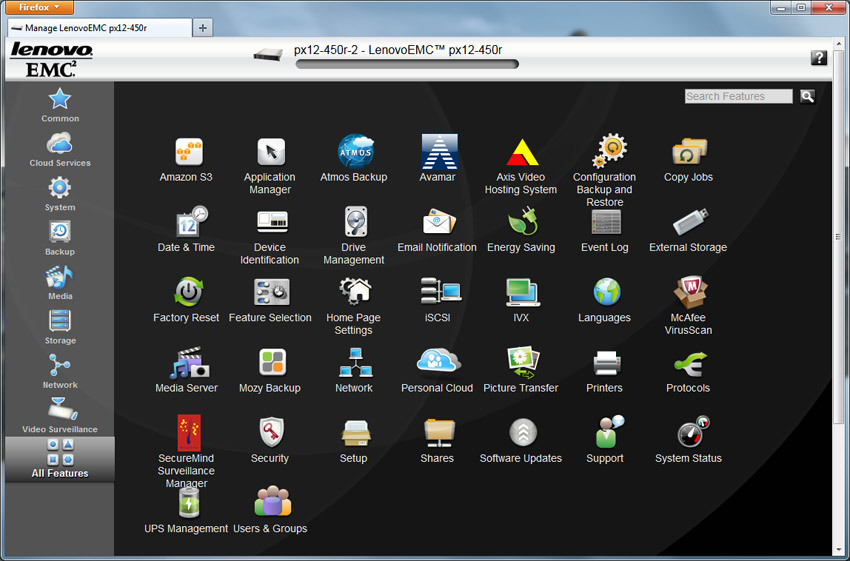
LenovoEMC Personal Cloud is a network architecture that connects other devices to the px12-450r via the Internet, including connectivity through iOS and Android applications. When using multiple LenovoEMC storage facilities in a company, LenovoEMC's unified product operating system offers several advantages: for example, two px12-450r devices located in different locations can be synchronized via the Personal Cloud as part of a disaster recovery plan.
Providing an appropriate and holistic testing environment is a key aspect of testing. If the hardware and infrastructure do not match the environment in which the equipment is deployed, a comparison may be meaningless. Our laboratory pays special attention to lenovo corporate servers , as well as infrastructure equipment, such as networks, rack space, power management and similar hardware to properly evaluate the quality of the device. Our tests are not paid or controlled by the equipment manufacturers.
Testing of the LenovoEMC px12-450r was performed on a second-generation enterprise platform on the Lenovo ThinkServer RD640. This Windows-based test platform includes the latest interconnect hardware such as the LSI 9207-8i HBA, as well as optimized I / O scheduling adapted for the best flash performance. For synthesized testing, we use FIO version 2.0.10 for Linux and version 2.0.12.2 for Windows.
In accordance with the process of testing hard drives, we previously put each drive in a stable state with the same load. Devices will be tested with a significant load of 16 threads with 16 queues in a stream, and then they will be tested with many variations of flows and queue depth to determine the effectiveness of work at low and heavy loads. Since hard drives reach their nominal performance level very quickly, we will only outline the main sections of each test.
An analysis of corporate synthesized workloads includes field trials. These tests are designed to simplify comparisons with past tests, as well as with widely publicized values, such as a maximum read and write speed of 4k, as well as a 70/30 8K read / write ratio, which is widely used in corporate drives.
4k
100% read or 100% write
100% 4k
8k 70/30
70% read 30% write
100% 8k
128k (sequential)
100% read or 100% write
100% 128k
We evaluated the performance of the 1GbE and 10GbE interfaces. To do this, we grouped the data and schemes for the test (4k, 8k, 128k) and the type of connection. In each category, 1GbE interface data is first presented, then 10GbE data. ISCSI is expected to perform better since we use a Linux-based array. In addition, when comparing certain data, we will focus on the totals.
At the first corporate load of the 1GbE interface to obtain the main results, we measured a large randomly selected 4k performance sample with 100% write and 100% read. The LenovoEMC px12-450r SCSI interface provides excellent read throughput at 2.153 IOPS, although it slows down a bit when writing.

In the main segment of the average delay time with a load of 16 threads (T) / 16 queues (Q), we found the average delay of LenovoEMC px12-450r iSCSI when reading 238.42 ms., Which is about four times less than that of SMB. The iSCSI latency during recording was 383.98 ms. compared to 311.44 for SMB.
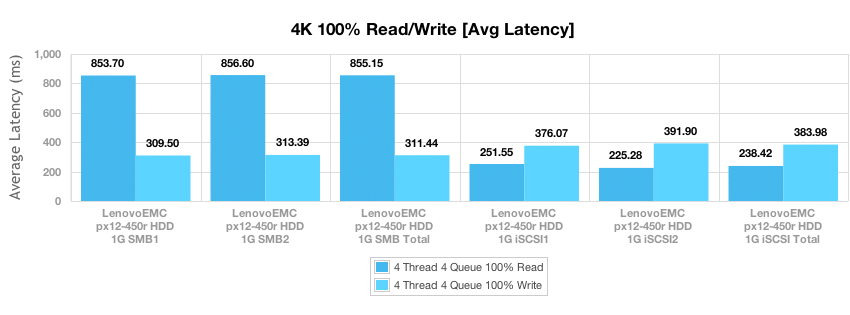
The results of the maximum reading delay for LenovoEMC px12-450r SBM are slightly higher than for iSCSI, at the level of 1,116 ms ... Although it was significantly lower than iSCSI for writing, 3,777.5 ms.
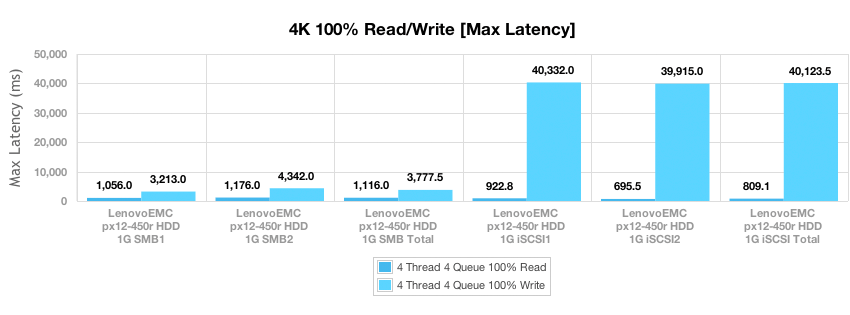
When measuring the stability of the 4k delay time in the deviation section, the results of LenovoEMC px12-450r SMB were 50.70 ms. when reading and 496.17 ms. when writing in comparison with the results of iSCSI 211, 00 ms. and 1,056.30 ms. respectively.
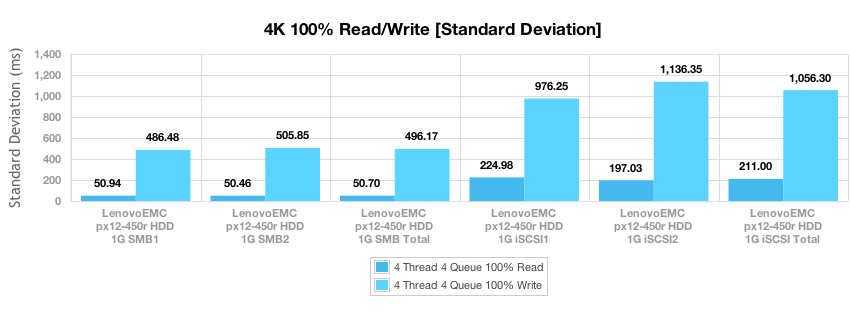
When testing the 10GbE interface to get the main results, we measured a large randomly selected 4k performance sample with 100% write and 100% read. The LenovoEMC px12-450r iSCSI is four times faster than the SMB in read bandwidth (2,119 IOPS), although when writing, the SMB took the lead with a slight advantage of 16 IOPS.

At a load of 16T / 16Q, measurements of the average reading delay showed 241.86 ms. LenovoEMC has a px12-450r, which is four times smaller than the SMB result. When recording, the average iSCSI delay was 5 ms. smaller.
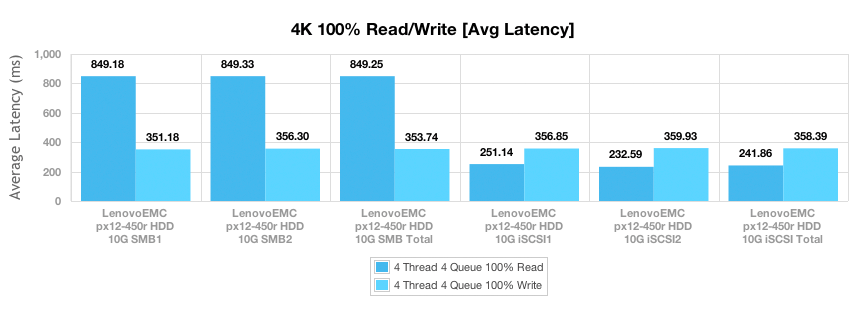
When measuring the maximum reading delay time, LenovoEMC px12-450r iSCSI showed the best result of 800.5 ms. However, the result when recording is 11 times higher at 47,021 ms. compared to 4,242 ms. at SMB.
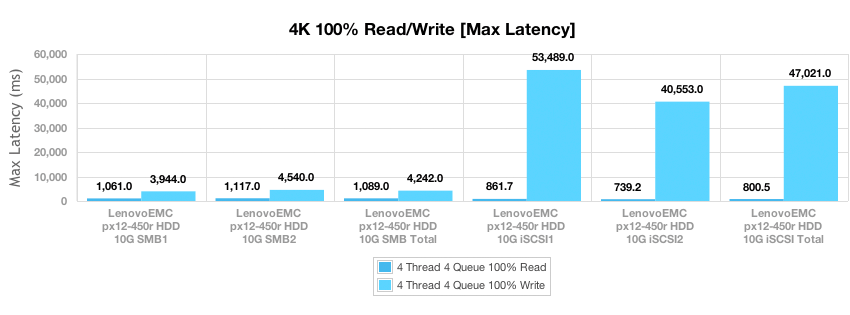
LenovoEMC px12-450r iSCSI showed a deviation of 222.83 ms. when reading in comparison with a standard deviation of 50.92 ms. at SMB. When measuring the stability of the delay time during recording, the SMB again exceeded iSCSI with a result of 582.50 ms. and 1,073.51, respectively.

Unlike the maximum load with 16 threads and 16 queues applied during testing of 100% 4k recording, mixed workload tests measure performance using a wide range of thread and queue combinations. In these tests, the workload varies from 2 threads and 2 queues to 16 threads and 16 queues. Throughout the 8k 70/30 test, the Lenovo EMC px12-450r iSCSI showed better throughput with a maximum of 880 IOPS and stayed at this level for almost the entire time of the test.

At 100% load 8k, LenovoEMC px12-450r iSCSI again showed better throughput at 28,677 IOPS for reading and 28,803 IOPS for writing.

When measuring the average latency, the LenovoEMC px12-450r iSCSI did not exceed 600 ms. compared to 875 ms. SMB
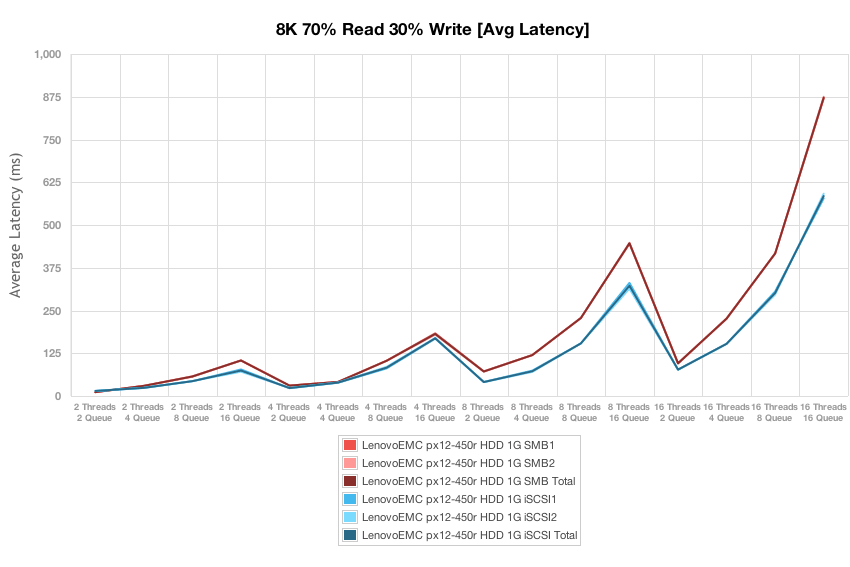
With a different number of threads and queues, the maximum latency of the LenovoEMC px12-450r iSCSI was 7,600 ms. compared to 13,750 ms. at SMB.
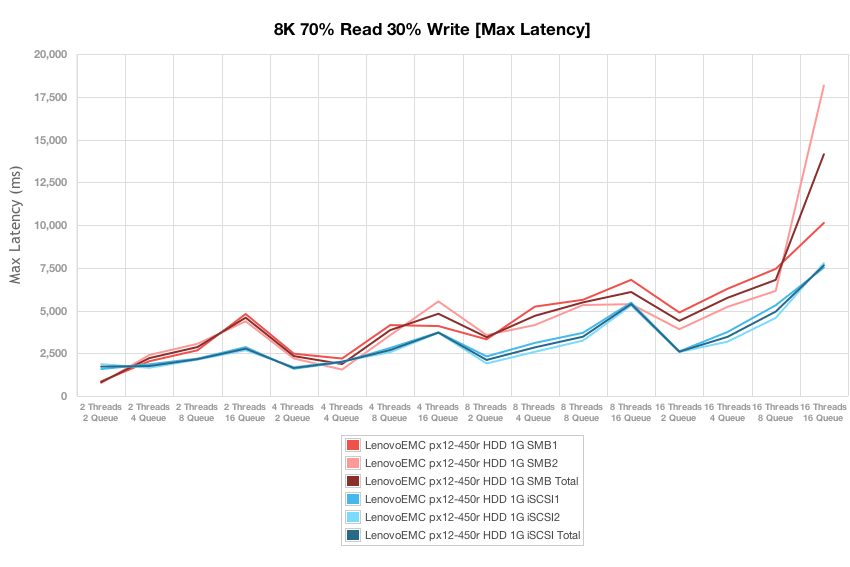
On almost the entire load range, LenovoEMC px12-450r iSCSI and SMB are not inferior to each other. Ultimately, the time delay deviation of the SMB is less than 900 ms. in comparison with 1,100 ms. iSCSI.

Unlike the maximum load with 16 threads and 16 queues applied during testing of 100% 4k recording, mixed workload tests measure performance using a wide range of thread and queue combinations. In these tests, the workload varies from 2 threads and 2 queues to 16 threads and 16 queues. In this test, the LenovoEMC px12-450r iSCSI behaved sequentially, often showing throughputs of 800 IOPS and higher. SMB reached 700 IOPS before dropping at maximum load of up to 500 IOPS.

At 100% load of 8k, the throughput of the LenovoEMC px12-450r iSCSI was almost four times higher than the throughput of SMB.

When measuring the average delay time, the LenovoEMC px12-450r iSCSI did not exceed 625 ms., SMB reached 975 ms ...
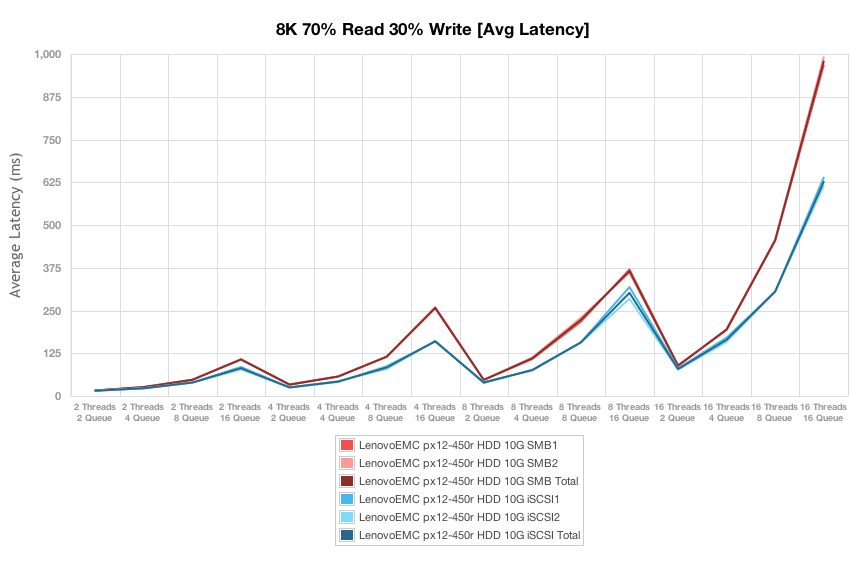
With a different number of threads and queues, the maximum delay time of the LenovoEMC px12-450r iSCSI was 8,000 ms. compared to 11,500 ms. at SMB.

Over almost the entire load range, LenovoEMC px12-450r iSCSI and SMB go side by side. SMB as a whole showed the best result before the load 16T8Q, where the maximum deviation of iSCSI was lower.
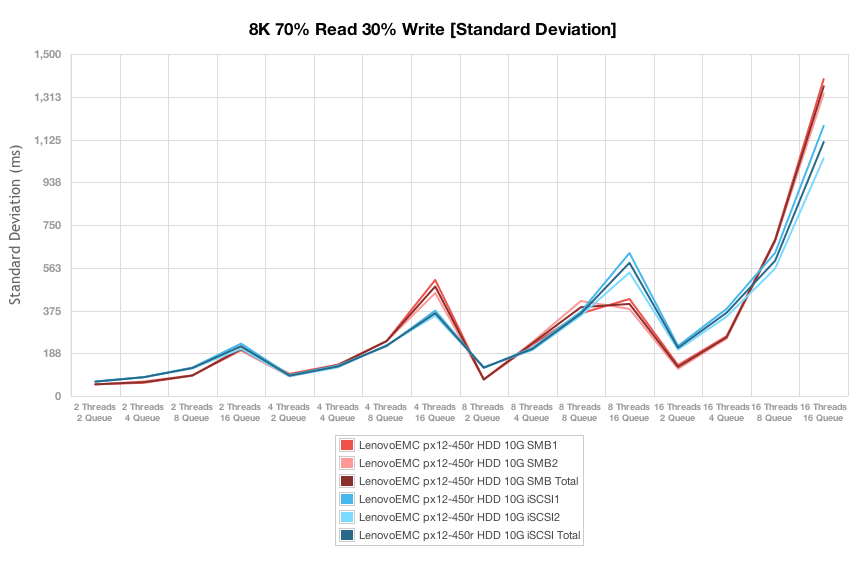
The next test in our corporate synthetic load analysis is the 128k test, which is the sequential control of a large data block showing the maximum serial transfer speed for the hard disk. With both 100% reading and 100% writing, the LenovoEMC px12-450r SMB shows better results with 260 968 Kb / s and 345 759 Kb / s, respectively.

When testing the 10GbE interface, the LenovoEMC px12-450r SMB again demonstrated better throughput, both in reading and writing, with 1,233,985 Kb / s and 1,512,465 Kb / s, respectively.

The decision to rename the Iomega product family by the name of the owner company indicates Lenovo and EMC's commitment to this line of software products. A series of networked storage arrays enables Lenovo to offer storage that they did not have before and adds EMC recognition to small businesses, which may one day lead to the classic line of storage arrays and networks. In particular, the px12-450r target audience is located on the border of small and medium businesses and corporations, where the conduct of a joint venture is of great importance. The px12-450r storage is distinguished by a four-core Intel Xeon processor, redundant, hot-swappable, power supply, four-channel aggregation on Gigabit Ethernet interfaces, an additional 10GbE network interface card with a dual interface that we installed,
When testing the Lenovo EMC px12-450r, we used a number of different configurations to get the most accurate results. We tested the iSCSI and SMB protocols, expecting the iSCSI results to be better because we used a Linux-based array. In addition, we tested the standard 1GbE and optional 10GbE interface. The results showed excellent performance of the LenovoEMC px12-450r, regardless of the Linux or Windows operating system, and yet with our iSCSI setting, the px12-450r produced significantly higher throughput. This was especially noticeable when testing the 8k 10GbE interface. ISCSI throughput was almost four times higher, at over 116,000 read IOPS and 91,000 write IOPS. iSCSI also showed the best throughput at 4k and 8k 70/30, although inferior to SMB in the 128k test.
LenovoEMC px12-450r offers small businesses a simple but well-designed networked array of storage from Lenovo and EMC. This multifunctional system is perfect for video surveillance, as well as a network storage for the Linux and Windows operating systems using the built-in 1GbE interface or additional 10GbE.
Prices for the PX12-450r range range from $ 4,420 for a complete set without disks, and up to $ 12,500 for a complete set with 48 terabytes.
You can buy Lenovo PX12-450R from official partners, you can find and contact them through the section on the Where to Buy website , we also provide a direct link to our partner’s Haber users where they will advise you on all Lenovo products, as well as sell the network Lenovo EMC px12-450r storage at a discount for Habrahabr users.
The original sources of this material on the network:
English version
Russian version

The technical specifications of the LenovoEMC px12-450r combined with the corporate functionality of EMC's LifeLine operating system mean that the px12-450r meets comprehensive storage requirements for small and medium businesses and remote office setup. With access to the EMC technology portfolio, the joint venture offers EMC Amavar data deduplication, integrated IVX imaging technology, EMC Atmos Cloud Connector, LifeLine-to-LifeLine copying and fault tolerance. This also applies to Lifeline developer apps. The px12-450r network array is flexible enough to integrate into existing networks as the target system for backup, data storage, or high-quality image storage.
LenovoEMC px12-450r NAS can be diskless, equipped with 4 RAID 5 drives, or equipped with a 48TB capacity in a RAID 6. The model we are considering is equipped with an additional 10Gbase-T PCI expansion card with two interfaces that will help evaluate the performance when using a solid state drive.
Technical specification LenovoEMC px12-450r:
- 2U Form Factor
- Maximum capacity: 48TB (12 x 3.5 ", support for twelve 3.5" SATA hard drives)
- Four 10/100/1000 Mbps Ethernet Ports
- Intel Xeon Quad Core E3-1265Lv2, 2.5 GHz
- RAM: 8 GB DDR3
- Possibility of two connections to a 10-gigabit network (requires the installation of an additional card on the PCI bus, sold separately)
- RAID 0, 1, 10, 5, 6, hot standby, simple JBOD array mode, automatic rebuild of RAID array, hot swap function.
- Redundant power supply: two hot-swappable power supplies
- Power consumption (Max .: 190 W, Min .: 55 W (low speed), Peak: 260 W for 10 sec
- USB 2.0: 3 ports (one front and two rear)
- LAN Standards: IEEE 802.3, IEEE 802.3u
- Supported network protocols: CIFS / SMB / Rally (Microsoft), NFS (Linux / UNIX), AFP / Bonjour (Apple), FTP, SFTP, TFTP, HTTP, HTTPS, WebDAV, Windows DFS, SNMP
- iSCSI: up to 256 nodes
- Block-level media pools: up to 32 LUN addresses per pool, no more than 128 storage addresses.
- File-level media pools: up to 256 LUN addresses per pool, no more than 256 LUNs per storage.
- What's in the box: Windows Active Directory, including Active Directory Hybrid Authentication (ADHA), Trusted Domains, Microsoft Cluster Server, and support for Hyper-V Live Migration.
- AC voltage 100–240 V, 50–60 GHz
- Acoustic noise not more than 48.5 dB (A)
- VGA port for local video control display using MindTree SecureMind VMS
- 3 year warranty
- Certificates: Windows Server 2008 R2 and Server 2012, VMware vSphere ESX 5.1 iSCSI and NAS, XenServer 5.5, 5.6 (w / MPIO), iSCSI & NFS
- Dimensions (length - width - height): 21.375 "(54.29cm) x 19.0" (48.26cm) x 3.5 "(8.89cm).
- Weight: 30.8 pounds (13.97 kg) without hard drives; 36.56 pounds (16.58 kg) with 4 hard drives 48.08 pounds (21.81 kg) with 12 hard drives.
Design and manufacture
The LenovoEMC px12-450r 2U high is supplied with a guide rail for 19 "standard units. The front panel provides access to 12 3.5-inch drive bays that can be used with hard drives or SSDs. The panel also has a power button, Power LED and USB port: Each drive bay is equipped with an LED indicator to indicate the status and activity of the drive.

The rear panel is equipped with connectors for two power supplies, which are automatically adjusted according to the input voltage. The System ID LED for device identification is activated using LifeLine management software, and the reset button resets the network and security settings without the need to completely return to the factory settings.

The px12-450r is equipped with two additional USB ports on the rear panel, as well as four integrated 1GbE interfaces. The VGA port can be used in conjunction with the video monitoring function. The device in question makes it possible to additionally connect 10GbE ports using a network expansion card.

LenovoEMC px12-450r is easy to maintain and repair due to the modular design of the motherboard, which can be easily separated from the chassis, being in the same unit with expansion cards. By unscrewing the two screws, you can upgrade your px12-450r in a few minutes with our optional 10GBase-t card.
Control system and operating system
Lenovo EMC NASs are powered by EMC LifeLine, a Linux-based operating environment that provides built-in management and integration tools and access to third-party applications. LifeLine provides access to subfile deduplication technology for backup data, as well as support for integrated IVX imaging technology for simultaneous management of several virtual machines on the px12-450r. In addition, Windows Distributed File Network (DFS) support allows you to organize network files into a unified directory tree. LifeLine also provides extra capacity by adding USB hard drives as shared resources.

LenovoEMC px12-450r NAS can run video monitoring installed in Mindtree software. In addition, the device comes with Mindtree SecureMind VSMS software with the ability to use on a single camera. LenovoEMC px12-450r can use up to 48 IP cameras along with additional integration with Axis Video Hosting Solution (AVHS) for security and other video applications. LifeLine is compatible with third-party cloud services, including Amazon S3 or Mozy, and with EMC Atmos Cloud Connector.

LenovoEMC Personal Cloud is a network architecture that connects other devices to the px12-450r via the Internet, including connectivity through iOS and Android applications. When using multiple LenovoEMC storage facilities in a company, LenovoEMC's unified product operating system offers several advantages: for example, two px12-450r devices located in different locations can be synchronized via the Personal Cloud as part of a disaster recovery plan.
Testing Information
Providing an appropriate and holistic testing environment is a key aspect of testing. If the hardware and infrastructure do not match the environment in which the equipment is deployed, a comparison may be meaningless. Our laboratory pays special attention to lenovo corporate servers , as well as infrastructure equipment, such as networks, rack space, power management and similar hardware to properly evaluate the quality of the device. Our tests are not paid or controlled by the equipment manufacturers.
Testing of the LenovoEMC px12-450r was performed on a second-generation enterprise platform on the Lenovo ThinkServer RD640. This Windows-based test platform includes the latest interconnect hardware such as the LSI 9207-8i HBA, as well as optimized I / O scheduling adapted for the best flash performance. For synthesized testing, we use FIO version 2.0.10 for Linux and version 2.0.12.2 for Windows.
- 2 x Intel Xeon E5-2620 (2.0GHz, 15MB Cache, 6 cores)
- Intel C602 System Controller
- Memory 16GB (2 x 8GB) 1333MHz DDR3 Register Memory
- Windows Server 2008 R2 SP1 64-bit, Windows Server 2012 Standard, CentOS 6.3 64-bit
- 100GB Micron RealSSD P400e Boot SSD
- LSI 9211-4i SAS / SATA 6.0Gb / s HBA (for boot SSDs)
- LSI 9207-8i SAS / SATA 6.0Gb / s HBA (for testing SSD or HDD)
- Intel X540-T2 10GbE PCIe 2.1 Adapter
- Mellanox ConnectX-3 10GbE PCIe 3.0 Adapter
- Mellanox ConnectX-3 InfiniBand PCIe 3.0 Adapter
Corporate Synthesized Workload Analysis
In accordance with the process of testing hard drives, we previously put each drive in a stable state with the same load. Devices will be tested with a significant load of 16 threads with 16 queues in a stream, and then they will be tested with many variations of flows and queue depth to determine the effectiveness of work at low and heavy loads. Since hard drives reach their nominal performance level very quickly, we will only outline the main sections of each test.
Preliminary preparation and main tests
- Throughput (total I / O operations per second (IOPS) when reading and writing)
- Average latency (average latency when reading and writing)
- Maximum delay time (Maximum delay time when reading and writing)
- Standard deviation of the delay time (Standard deviation of the delay time when reading and writing)
An analysis of corporate synthesized workloads includes field trials. These tests are designed to simplify comparisons with past tests, as well as with widely publicized values, such as a maximum read and write speed of 4k, as well as a 70/30 8K read / write ratio, which is widely used in corporate drives.
4k
100% read or 100% write
100% 4k
8k 70/30
70% read 30% write
100% 8k
128k (sequential)
100% read or 100% write
100% 128k
We evaluated the performance of the 1GbE and 10GbE interfaces. To do this, we grouped the data and schemes for the test (4k, 8k, 128k) and the type of connection. In each category, 1GbE interface data is first presented, then 10GbE data. ISCSI is expected to perform better since we use a Linux-based array. In addition, when comparing certain data, we will focus on the totals.
At the first corporate load of the 1GbE interface to obtain the main results, we measured a large randomly selected 4k performance sample with 100% write and 100% read. The LenovoEMC px12-450r SCSI interface provides excellent read throughput at 2.153 IOPS, although it slows down a bit when writing.

In the main segment of the average delay time with a load of 16 threads (T) / 16 queues (Q), we found the average delay of LenovoEMC px12-450r iSCSI when reading 238.42 ms., Which is about four times less than that of SMB. The iSCSI latency during recording was 383.98 ms. compared to 311.44 for SMB.

The results of the maximum reading delay for LenovoEMC px12-450r SBM are slightly higher than for iSCSI, at the level of 1,116 ms ... Although it was significantly lower than iSCSI for writing, 3,777.5 ms.

When measuring the stability of the 4k delay time in the deviation section, the results of LenovoEMC px12-450r SMB were 50.70 ms. when reading and 496.17 ms. when writing in comparison with the results of iSCSI 211, 00 ms. and 1,056.30 ms. respectively.

When testing the 10GbE interface to get the main results, we measured a large randomly selected 4k performance sample with 100% write and 100% read. The LenovoEMC px12-450r iSCSI is four times faster than the SMB in read bandwidth (2,119 IOPS), although when writing, the SMB took the lead with a slight advantage of 16 IOPS.

At a load of 16T / 16Q, measurements of the average reading delay showed 241.86 ms. LenovoEMC has a px12-450r, which is four times smaller than the SMB result. When recording, the average iSCSI delay was 5 ms. smaller.

When measuring the maximum reading delay time, LenovoEMC px12-450r iSCSI showed the best result of 800.5 ms. However, the result when recording is 11 times higher at 47,021 ms. compared to 4,242 ms. at SMB.

LenovoEMC px12-450r iSCSI showed a deviation of 222.83 ms. when reading in comparison with a standard deviation of 50.92 ms. at SMB. When measuring the stability of the delay time during recording, the SMB again exceeded iSCSI with a result of 582.50 ms. and 1,073.51, respectively.

Unlike the maximum load with 16 threads and 16 queues applied during testing of 100% 4k recording, mixed workload tests measure performance using a wide range of thread and queue combinations. In these tests, the workload varies from 2 threads and 2 queues to 16 threads and 16 queues. Throughout the 8k 70/30 test, the Lenovo EMC px12-450r iSCSI showed better throughput with a maximum of 880 IOPS and stayed at this level for almost the entire time of the test.

At 100% load 8k, LenovoEMC px12-450r iSCSI again showed better throughput at 28,677 IOPS for reading and 28,803 IOPS for writing.

When measuring the average latency, the LenovoEMC px12-450r iSCSI did not exceed 600 ms. compared to 875 ms. SMB

With a different number of threads and queues, the maximum latency of the LenovoEMC px12-450r iSCSI was 7,600 ms. compared to 13,750 ms. at SMB.

On almost the entire load range, LenovoEMC px12-450r iSCSI and SMB are not inferior to each other. Ultimately, the time delay deviation of the SMB is less than 900 ms. in comparison with 1,100 ms. iSCSI.

Unlike the maximum load with 16 threads and 16 queues applied during testing of 100% 4k recording, mixed workload tests measure performance using a wide range of thread and queue combinations. In these tests, the workload varies from 2 threads and 2 queues to 16 threads and 16 queues. In this test, the LenovoEMC px12-450r iSCSI behaved sequentially, often showing throughputs of 800 IOPS and higher. SMB reached 700 IOPS before dropping at maximum load of up to 500 IOPS.

At 100% load of 8k, the throughput of the LenovoEMC px12-450r iSCSI was almost four times higher than the throughput of SMB.

When measuring the average delay time, the LenovoEMC px12-450r iSCSI did not exceed 625 ms., SMB reached 975 ms ...

With a different number of threads and queues, the maximum delay time of the LenovoEMC px12-450r iSCSI was 8,000 ms. compared to 11,500 ms. at SMB.

Over almost the entire load range, LenovoEMC px12-450r iSCSI and SMB go side by side. SMB as a whole showed the best result before the load 16T8Q, where the maximum deviation of iSCSI was lower.

The next test in our corporate synthetic load analysis is the 128k test, which is the sequential control of a large data block showing the maximum serial transfer speed for the hard disk. With both 100% reading and 100% writing, the LenovoEMC px12-450r SMB shows better results with 260 968 Kb / s and 345 759 Kb / s, respectively.

When testing the 10GbE interface, the LenovoEMC px12-450r SMB again demonstrated better throughput, both in reading and writing, with 1,233,985 Kb / s and 1,512,465 Kb / s, respectively.

Conclusion
The decision to rename the Iomega product family by the name of the owner company indicates Lenovo and EMC's commitment to this line of software products. A series of networked storage arrays enables Lenovo to offer storage that they did not have before and adds EMC recognition to small businesses, which may one day lead to the classic line of storage arrays and networks. In particular, the px12-450r target audience is located on the border of small and medium businesses and corporations, where the conduct of a joint venture is of great importance. The px12-450r storage is distinguished by a four-core Intel Xeon processor, redundant, hot-swappable, power supply, four-channel aggregation on Gigabit Ethernet interfaces, an additional 10GbE network interface card with a dual interface that we installed,
When testing the Lenovo EMC px12-450r, we used a number of different configurations to get the most accurate results. We tested the iSCSI and SMB protocols, expecting the iSCSI results to be better because we used a Linux-based array. In addition, we tested the standard 1GbE and optional 10GbE interface. The results showed excellent performance of the LenovoEMC px12-450r, regardless of the Linux or Windows operating system, and yet with our iSCSI setting, the px12-450r produced significantly higher throughput. This was especially noticeable when testing the 8k 10GbE interface. ISCSI throughput was almost four times higher, at over 116,000 read IOPS and 91,000 write IOPS. iSCSI also showed the best throughput at 4k and 8k 70/30, although inferior to SMB in the 128k test.
Benefits
- Easy setup and controls for quick launch
- Link Aggregation and Other Enterprise Capabilities with EMC LifeLine
- Easy to upgrade and maintain thanks to a retractable controller unit
disadvantages
- Compatible with 10GBase-T 10GbE only
Conclusion
LenovoEMC px12-450r offers small businesses a simple but well-designed networked array of storage from Lenovo and EMC. This multifunctional system is perfect for video surveillance, as well as a network storage for the Linux and Windows operating systems using the built-in 1GbE interface or additional 10GbE.
Where to buy, prices
Prices for the PX12-450r range range from $ 4,420 for a complete set without disks, and up to $ 12,500 for a complete set with 48 terabytes.
You can buy Lenovo PX12-450R from official partners, you can find and contact them through the section on the Where to Buy website , we also provide a direct link to our partner’s Haber users where they will advise you on all Lenovo products, as well as sell the network Lenovo EMC px12-450r storage at a discount for Habrahabr users.
The original sources of this material on the network:
English version
Russian version
